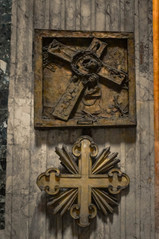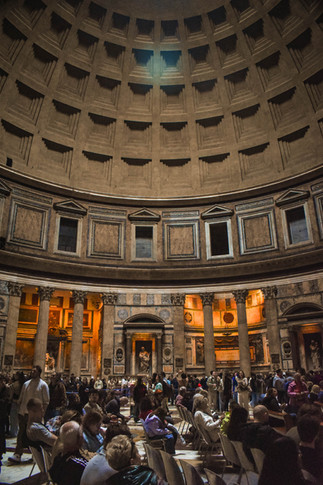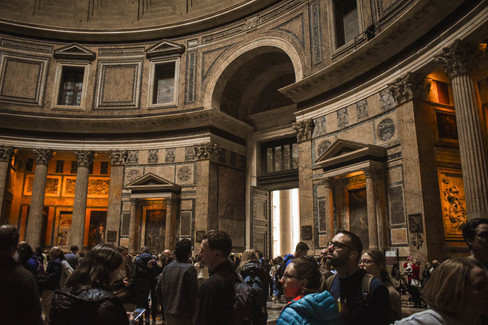The Pantheon
- Jo
- May 21
- 4 min read
The Pantheon is an ancient Roman temple in Rome, Italy, which has been converted into a church. It's renowned for its impressive dome, the largest unsupported concrete dome in the world, and its central oculus (a circular opening). The structure was built on the site of an earlier temple, and its current form was completed around 126-128 AD, during the reign of Emperor Hadrian

When researching this magnificent building, I found this interesting site with 17 astounding facts about the building. The current building is almost over 2000 years old, but there were 2 other buildings on this site before. Here is what The Roman Guy's site has to say about the 3 buildings:
According to Amanda Claridge, the Pantheon was first built between 27-25 B.C., but that building would not be recognizable today. The first structure was built by Marcus Agrippa, a Roman Consul under the first Emperor of Rome, Ceaser Augustus. The original structure was built primarily out of wood and subsequently burnt down about 100 years later in A.D. 80.
Domitian took a second shot at it, but the structure was struck by lightning and burned to the ground in A.D. 110. At the time, these incidents would have come across as very bad omens for Rome during an otherwise prosperous time. Lightning was controlled by Jupiter (Zeus), and if it struck the building, it would likely signify he was unhappy with it or the Romans in general.
Trajan, emperor at the time, likely began the third structure, and Hadrian would have finished it. Hadrian was a great emperor and was very humble, so he did not dedicate the structure to himself, something he only did once. Instead, he dedicated it to the man who originally built it: Marcus Agrippa.
The inscription on the front reads: M AGRIPPA L. F. COS TERTIUM FECIT or “Marcus Agrippa, Son of Lucius, Thrice Consul, Made This.”


One of the strangest facts about the Pantheon is that we don’t know who or why it was built. The word “pantheon” translates all-gods. Contrary to what many have written on the internet, the use of the building was not to worship all pagan gods. Pagan gods didn’t appreciate sharing a temple with other gods.
What the Romans used the Pantheon for is undocumented. It is no mystery that Romans didn’t like to worship emperors as gods until after their death.
One of the most astounding facts about the Pantheon is its survival. In A.D. 609, the Pantheon was converted into a church by Pope Boniface IV. This is the principal reason that the building is still standing today. Once it was a church, nobody was allowed to loot it. It’s still a church to this day and is called St. Mary and the Martyrs.
The first King of Italy, Vittorio Emanuele, is buried here. Emmanuel’s army, led by the great Giuseppe Garibaldi, successfully unified the peninsula under the rule of one monarch. Victor Emmanuel II died in 1878 and was buried in the Pantheon. His tomb reads Padre della Patria, which translates to the “Father of the Fatherland.” The fact that he was allowed to be buried here is a mystery.
Pope Pius IX refused to meet with Emmanuel after he overtook Rome and never acknowledged his reign. Then, he allowed him to be buried inside the Pantheon, a Catholic Church.


Another interesting fact is that Raphael, an Italian painter and architect of the High Renaissance, is buried here. Raphael’s tomb is on the back left-hand side of the structure. Raphael, who lived from 1483 to 1520 and may have died on his birthday, is located under a statue of Mary holding baby Jesus to her left, which was done by an artist named Lorenzetto.
His tomb reads ILLE HIC EST RAFFAEL, TIMUIT QUO SOSPITE VINCI, RERUM MAGNA PARENS ET MORIENTE MORI. Translated by Alexander Pope, it reads, “Living, great nature feared he might outvie Her works; and, dying, fears herself may die.”

Once you walk inside, your eyes will be drawn to the dome above you. Many people stop in the doorway, causing traffic jams, and I can’t blame them. That’s exactly the effect the architect would have longed for.
The architecture of Rome was heavily focused on showing the superiority of the Romans, and the Pantheon was no different. The opening in the center is called an oculus in Latin, which means “eye.” Rain and other elements do get inside the structure when the doors are closed.
The floor slopes down into the center and drains in place to allow water to leave the structure. By having an opening in the middle like that, it would have allowed for natural light to enter and brighten the entire temple.


The building is 145 feet (44.4 meters) tall by 145 feet (44.4 meters) wide and built completely from stone, brick, and concrete.
The dome is made entirely out of concrete with five rows of 28 coffers that decrease in size as you get closer to the oculus. Archaeologists have studied the building extensively and realized that they used lighter and lighter materials in the cement the higher up they got. This allowed the building to sustain all the pressure on it.
It is a must-see place if you ever find yourself in the Eternal City.


As always, thank you for taking the time to read my Blog.





















Comments